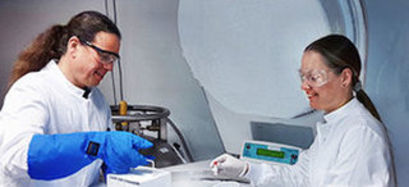This was the starting point of the German-Ukrainian project, which was completed on 30 September after a two-year term. The aim of this project was to collect data to simulate long-term storage and therefore make it possible to estimate reductions in quality and quantity.
Normally, many years pass between the time when the stem cells are frozen and when they are used, during which period they are stored at cryobanks, in liquid nitrogen tanks at a temperature of -196°C. The challenges of long-term storage include reduced survival rates and possible reductions in quality. In addition, there is a lack of knowledge regarding whether artificial genetic cell modifications, such as a reduction in immuno-rejections, are influenced negatively by storage.
Optimisation of storage and production costs
The long-term cryologs optimised in the project can be used to lower storage and production costs because fewer cells need to be frozen for a long time to achieve the same survival rates. This is particularly important in stem cell biology, reproductive and transfusion medication, and even when storing just a few cells, as they are highly valuable due to their functions or haplotype. In addition, simulated long-term storage can also be used to compile a survival and functional forecast before freezing the cells, which can have economic benefits during later clinical application.
Special results and successes of the project
Controlled fluctuated temperature cycles were employed to successfully put together a simulated storage log for the period of 20 years in only 2 weeks. This simulation method can be applied to other clinically relevant types of cells at any time and be used as a forecasting test and be patented, if necessary. A very profitable knowledge transfer from the Ukraine took place regarding the biobank technology used in storing adult stem cells, cell concentrations and testing different antifreezes as well as freezing rates.
Furthermore, the cells improved during the quality check based on new test processes (including apoptosis and cell survival markers as well as cell metabolism tests).
Added value of the international cooperation
The complementary knowledge of Ukrainian and German scientists was combined successfully as part of the cross-border collaboration of cell and cryobiologists, stem cell researchers and medical specialists in the context of the Federal Government’s Ukraine Action Plan. In this context, the infrastructure of the relevant partner institutes in Hanover and Charkiw was used intensively. The results have already been presented at research events and conferences, and a publication for a scientific journal is also being prepared. Educating young scientists also formed a key part of the cooperation.
Funding was supported by the International Bureau.
Contact
Dr Thomas Reineke
DLR Project Management Agency | International Bureau
Tel.: +49 228 3821 1448
thomas.reineke@dlr.de
Dr Thomas Müller
Hanover Medical University
Tel.: +49 511 532 5208
mueller.thomas@mh-hannover.de
Institute of Cryobiology Issues and Cryomedicine at the Ukrainian National Academy of Sciences, Charkiw








